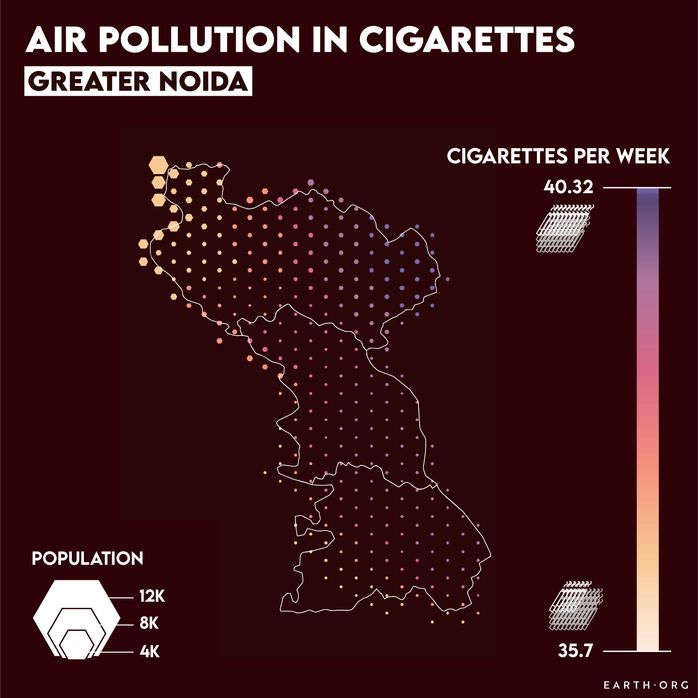Until recently, it was estimated air pollution killed ~7 million people a year, but a study re-evaluated it to 10 million. This means air pollution surpasses cancer as the second-worst cause of death after heart disease. Here, we go over the 15 most polluted cities in the world, most of which are found in two countries.
—
According to IQAIR, these are the 15 most polluted cities in the world as of August 2021.

IQAIR most polluted cities, August 26th 2021.
To help you put these levels of pollution into perspective, we mapped a few of these cities using Berkeley Earth’s air pollution to cigarette equivalence. It translates fine particulate matter (PM2.5) concentrations into the amount of cigarettes smoked that would produce the same health risks.
- Bhulandshahr
Bhulandshahr is satellite city of Delhi, suffering from heavy vehicular pollution, poorly regulated industrial activity, dust from construction sites, and compounding meteorological conditions, making it the second most polluted city in India.

- Noida and Greater Noida
6th of the most polluted cities in the world is Noida, a satellite city of Delhi, which suffers its worst spells of air pollution during the months of September through December. Farmers burn the stubble off of their crops in order to quickly make way for the next round, and emissions usually linger due to seasonal weather patterns. This unfortunate combination makes Noida one of the most polluted cities in the world.
Greater Noida is one of India’s planned cities located in the suburban district of Gautam Budh Naghar in Uttar Pradesh. It was built as an extension of the Noida area and to relieve the demographic burden in Delhi, housing many of India’s largest industrial plants and residential properties. This rapid urban development produced the highest levels of dust and particulate pollution in recorded history.

- Kanpur
Kanpur, a metropolitan city in the state of Uttar Pradesh, is the birthplace to some of the world’s largest leather manufacturers. The large number of leather tanneries, coupled with vehicle emissions and an abundance of coal-burning facilities, produces one of the world’s most toxic cases of airborne pollution.

- Lucknow
Lucknow is the capital of the most populous state in India, Uttar Pradesh. The city has a humid, subtropical climate that slows down the dispersion of pollutants from the air. It also suffers from unchecked vehicular and construction site pollution, along with cases of illegal refuse incineration.

- Delhi
Delhi is the capital city of India with a population of over 18 million. Among many of the cities in India, Delhi suffers from some of the highest cases of particulate matter concentration in the world. The prominence of new small-scale industries including brick kilns and diesel generators have adversely affected millions who have been exposed to the toxic smog for extended periods of time.

India and China’s overwhelming presence in this list does not come as a surprise. As the two most populous and rapidly developing industrial powers in the world, pollution is unavoidable. They’ve both improved in this area in recent years, but some areas remain outright dangerous to live in, and policy is moving sluggishly.
A commonality between these two countries is that both have centralized governments with little authority assigned over to state and local governments. The latter are more likely to try to improve their constituents’ quality of life, while the former seems to prioritize country-wide economic growth over quality of life.
Indeed, this is what it boils down to – is the government ready to sacrifice financial development for environmental and human health?
It is difficult to point fingers when every developed nation today went through a phase of heavy pollution and environmental degradation before toning it down. Of course, they only did so once they were fully developed, and some are still far from role models.
China and India are still heavily reliant on coal, the main driver behind air pollution since the industrial revolution, and until this changes, air quality will remain a problem. Moreover, sheer population size leads to the formation of megalopolises, which, combined with poor meteorological conditions inevitably create poor atmospheric conditions.
Does this mean the governments aren’t at fault at all? Not quite. While China has made great progress on this front, regulatory policy has been intentionally slow, putting development first. What policy there is is further hampered by corruption, still rampant in India today though less so in China.
In the northern Indian state of Haryana, industrialists paid off officials to learn information about surprise raids by the State Pollution Control Board (SPCB). The irrigation systems in India are substandard because of contractors desiring lower costs, and village elites bribe forestry officials for harvests well beyond regulated amounts, which increases problems like deforestation and stubble burning.
While both these countries have a valid argument in saying development goes hand in hand with pollution, over a million die from air pollution each year in both countries. They have the option of not reproducing other countries’ mistakes, while also doing what is right by their people.
This article was written by Austin Gigi and Owen Mulhern.
You might also like: What is the Tragedy of the Commons?










![The Statistics of Biodiversity Loss [2020 WWF Report]](https://u4d2z7k9.rocketcdn.me/wp-content/uploads/2020/12/lprwinkyTHB-544x306.jpg)





